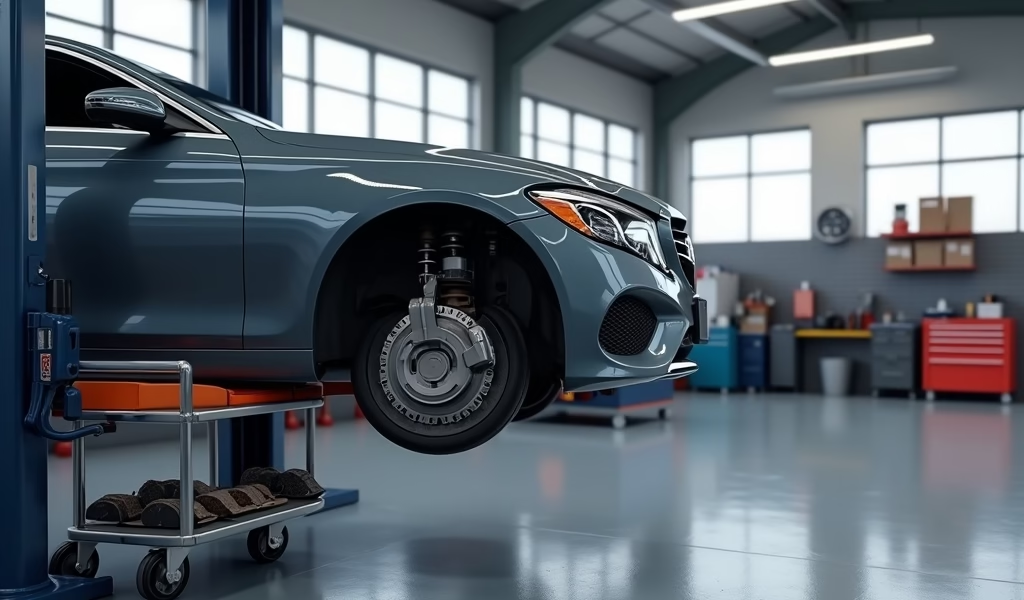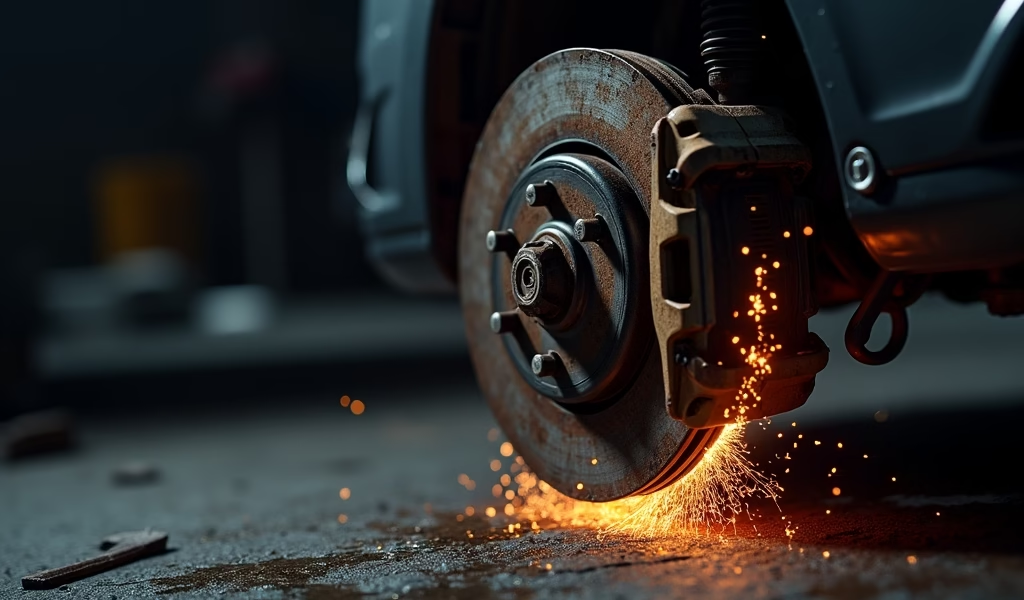Overview
This article outlines five strategies to reduce brake service costs without compromising safety: scheduling regular inspections to catch issues early, comparing service quotes thoughtfully beyond just price, using quality aftermarket parts instead of OEM, performing simple brake jobs yourself if you have the skills, and adopting driving habits that extend brake life. The author, an experienced mechanic, emphasizes that preventative maintenance and smart consumer choices can save hundreds of dollars while maintaining optimal braking performance, which is critical for vehicle safety.
Brake Service Cost: 5 Smart Ways to Save Without Compromising Safety
Your brakes are your car’s most critical safety system, yet many drivers put off essential brake work because they’re worried about the cost. Trust me, I’ve seen the white-knuckle grip on the steering wheel when I tell folks their brake service estimate. Having worked under countless vehicles for over 15 years, I understand that sinking feeling when an unexpected repair bill threatens your monthly budget.
The good news? You don’t have to choose between safe brakes and paying your electric bill. With a little knowledge and planning, you can keep your stopping power strong without emptying your wallet.
Table of Contents
- Understanding Brake Service: What You’re Really Paying For
- Signs You Need Brake Service (Don’t Ignore These!)
- Average Brake Service Costs Across Vehicle Types
- Saving Strategy #1: Regular Inspections Save Big Money
- Saving Strategy #2: Compare Quotes (But Not Just Prices)
- Saving Strategy #3: Consider Quality Aftermarket Parts
- Saving Strategy #4: DIY The Right Brake Jobs
- Saving Strategy #5: Maintenance Practices That Extend Brake Life
- Conclusion: Smart Brake Maintenance Means Safety And Savings
- Frequently Asked Questions
Understanding Brake Service: What You’re Really Paying For
When you hand over your hard-earned money for brake service, you’re not just paying for parts—you’re investing in the system that could save your life and others’ on the road. Just last month, I had a customer named Mike who came in complaining about “just a little squeaking” in his brakes. When we got his car on the lift, his brake pads were worn down to metal, and his rotors looked like they’d been attacked by a cheese grater. What could have been a simple $150 pad replacement turned into a $600 ordeal.
The core components of a brake service usually include brake pads, rotors (sometimes called discs), calipers, and brake fluid. Your typical brake pad replacement cost might range from $100-$300 per axle, depending on your vehicle and the quality of parts used. Rotors add another $200-$400 per axle to resurface or replace, while calipers can run $100-$150 each if they need replacement.
Labor is the other major chunk of your brake service bill. Shop rates vary widely from $75 to $150 per hour depending on where you live and whether you’re at a dealership, independent shop, or chain store. A complete brake job might take 1-3 hours per axle.
Signs You Need Brake Service (Don’t Ignore These!)
Your brakes have a language of their own, and they’re constantly telling you about their condition if you know how to listen. The most obvious signal is that high-pitched squeal—like fingernails on a chalkboard—which comes from the wear indicators deliberately built into brake pads. This isn’t just annoying; it’s an engineered warning system telling you “service me now before things get expensive!”
Beyond the screech, pay attention to these warning signs that scream “brake service needed”:
- Grinding noises (metal-on-metal contact—very bad news)
- Vibration or pulsation when braking
- Soft or spongy brake pedal feel
- Vehicle pulling to one side during braking
- Longer stopping distances than usual
- Brake warning light illuminated on dashboard
I still remember Sarah, who ignored her grinding brakes for weeks. “I just turned up the radio,” she admitted sheepishly. By the time she came in, her caliper had scored deep grooves into her rotor, and metal shavings had contaminated the brake fluid. What should have been a $200 repair ballooned to over $800. The moral: those warning signs aren’t suggestions—they’re urgent alerts from your vehicle.

Average Brake Service Costs Across Vehicle Types
Not all brake jobs are created equal. Your vehicle type plays a major role in determining your brake service bill. Economy cars typically have the most affordable brake components, while luxury vehicles can cost three times as much for essentially the same work. Here’s a breakdown of what you might expect to pay for a complete brake service (pads and rotors) on both axles:
Economy cars (Honda Civic, Toyota Corolla): $350-$550
Mid-range sedans and SUVs (Ford Explorer, Honda Accord): $450-$700
Luxury vehicles (BMW, Mercedes, Audi): $700-$1,200
Performance vehicles (Porsche, high-performance trims): $1,000-$2,000+
I once had a customer drive in with his Porsche Cayenne Turbo, expecting to pay “a few hundred bucks” for new brakes. The look on his face when I showed him the estimate for $1,800 was priceless. “But they’re just brakes!” he exclaimed. What he didn’t realize was that his performance vehicle used special high-temperature pads and cross-drilled rotors designed to dissipate heat under extreme conditions. Those fancy red calipers weren’t just for show!
The type of brake replacement needed also impacts your final bill. A basic pad swap is the least expensive service, while replacing calipers, rotors, and lines in addition to pads represents the higher end of the cost spectrum. According to AAA’s brake repair study, the average driver spends between $500 and $1,200 on comprehensive brake work.
Saving Strategy #1: Regular Inspections Save Big Money
The penny-wise, pound-foolish approach is never more dangerous than with brake maintenance. Regular inspections might seem like an unnecessary expense, but they’re actually your financial lifeline.
Case in point: Tom brought his Subaru in for a routine oil change, and I offered our complimentary brake check. We discovered his pads were at 20% life—not yet metal-on-metal, but getting close. For $180, we replaced just the pads. Had he waited another month or two, he’d have needed new rotors too, easily doubling his bill.
Most reputable shops offer free brake inspections, especially when you’re already there for other maintenance. Take advantage of these! I recommend visual brake checks every 6 months or 6,000 miles, whichever comes first. At minimum, have your brakes thoroughly inspected during each oil change.
The math is simple: Early detection of brake wear = pad replacement only. Late detection = pads, rotors, and possibly calipers. The difference can easily be $300-600 per axle. Some forward-thinking service centers even offer brake maintenance programs where you pay a small monthly fee for regular inspections and discounted parts when needed.
Saving Strategy #2: Compare Quotes (But Not Just Prices)
Shopping around for brake service quotes makes good financial sense, but focusing solely on the bottom line can be a costly mistake. I’ve had countless customers bring in estimates from other shops that seemed too good to be true—and they usually were.
When gathering quotes, ask these specific questions:
- Are you quoting OEM (Original Equipment Manufacturer), premium aftermarket, or economy parts?
- Does this include resurfacing or replacing rotors?
- What’s your warranty on parts and labor?
- Does this price include brake fluid flush if needed?
- Will you provide a thorough inspection of the entire system?
I once had a customer, Lisa, who chose the lowest quote she found—$220 for front brakes compared to our $320 estimate. She was back two months later with vibration issues. The discount shop had slapped on cheap pads without addressing her warped rotors. We ended up replacing both rotors and pads properly for $400, meaning her “bargain” ultimately cost her $620.
Get at least three quotes from different types of service providers: a dealership, an independent shop, and a chain brake specialist. Their approaches and pricing structures differ significantly. Dealerships generally charge premium rates but use OEM parts. Independent shops often offer the best balance of quality and value, while chain stores frequently advertise specials but may upsell aggressively.
Saving Strategy #3: Consider Quality Aftermarket Parts

One of the automotive industry’s best-kept secrets is that many aftermarket brake components equal or exceed OEM quality at substantially lower prices. The key word here is “quality”—not all aftermarket parts deserve space on your vehicle.
Premium aftermarket brands like Akebono, Centric, Brembo, and Wagner produce excellent brake components that often outperform original equipment. Mid-tier brands like Raybestos and ACDelco offer solid performance at more moderate prices.
The real savings come from the markup difference. Dealerships typically mark up OEM parts 40-100% over their cost, while aftermarket parts usually carry smaller margins. By requesting quality aftermarket components, you might save 30-50% on parts costs alone.
A customer I’ll call Robert came in with his 5-year-old BMW 328i needing rear brakes. The dealership quoted him $780 for pads, rotors, and labor. We installed premium Akebono ceramic pads and Centric rotors for $420 total. Three years later, his brakes are still performing flawlessly.
According to Consumer Reports research, drivers can save an average of 25-40% by choosing independent shops using quality aftermarket parts over dealership service using OEM components.
Saving Strategy #4: DIY The Right Brake Jobs
For the mechanically inclined, certain brake maintenance tasks are surprisingly accessible as DIY projects. I’m not suggesting everyone should tackle their own brake overhaul, but simple jobs like pad replacement on most vehicles require basic tools and moderate technical skills.
Before you roll up your sleeves, honestly assess which brake jobs are DIY-appropriate:
- Brake pad replacement: Often DIY-friendly on most vehicles
- Rotor replacement: Moderate difficulty, requires more tools
- Caliper replacement: More challenging, involves brake fluid management
- Brake line replacement/brake bleeding: Not recommended for beginners
I remember teaching my neighbor Jeff how to change the pads on his Chevy Silverado. We spent a Saturday afternoon in his garage, and for about $100 in parts and a case of beer (his “labor cost” to me), he saved around $250 compared to shop prices. He’s done his own pad replacements ever since.
If you’re considering the DIY route, factor in these hidden costs: specialty tools you might need to purchase, the possibility of encountering unexpected problems, and most importantly—the safety implications. When in doubt, leave it to professionals. No amount of savings justifies compromising your vehicle’s most critical safety system.
YouTube tutorials from respected mechanics like ChrisFix provide excellent step-by-step guidance for common brake repairs. Online auto parts retailers often offer better prices than local stores, with the convenience of exact vehicle matching.
Saving Strategy #5: Maintenance Practices That Extend Brake Life
The cheapest brake job is the one you don’t need yet. By adopting certain driving and maintenance habits, you can significantly extend your brake system’s lifespan, potentially doubling the time between services.
Driving technique has a profound impact on brake wear. I once had two identical Honda CR-Vs come in for service—same year, similar mileage. One needed new front brakes at 25,000 miles; the other’s original brakes were still going strong at 60,000 miles. The difference? Driving habits.
Here’s how to make your brakes last longer:
- Anticipate stops: Look ahead and coast to decelerate when possible
- Practice engine braking: Downshift to slow down (especially effective on hills)
- Avoid “two-foot driving”: Never rest your left foot on the brake pedal
- Reduce excess weight: Remove unnecessary heavy items from your vehicle
- Address grinding noises immediately: Don’t let minor problems become major repairs
Routine brake fluid maintenance is another often-overlooked aspect of brake longevity. Brake fluid naturally absorbs moisture over time, leading to decreased performance and internal corrosion. Having your brake fluid flushed every 2-3 years (or per manufacturer recommendations) costs around $100 but can prevent premature wear of components costing many times that amount.
The math is compelling: extending your brake life from 30,000 to 60,000 miles effectively cuts your lifetime brake service costs in half. For many vehicles, that represents thousands of dollars in savings over your ownership period.
Conclusion: Smart Brake Maintenance Means Safety And Savings
Your vehicle’s brakes deserve the same thoughtful attention you’d give any critical safety system. The good news is that being brake-smart doesn’t mean emptying your bank account. Through preventative maintenance, educated consumer choices, and responsible driving habits, you can maintain peak braking performance while keeping costs under control.
Remember that woman I mentioned earlier—Sarah with her grinding brakes? She’s now my poster child for preventative maintenance. After her expensive lesson, she now schedules regular inspections and addresses minor issues immediately. Her current vehicle has 120,000 miles and has needed only standard brake service at normal intervals.
The relationship between your safety and your wallet doesn’t have to be adversarial. With the strategies outlined above, you can protect both. Your future self will thank you—both when you need to stop suddenly in traffic, and when you have extra money in your savings account.
Now that you understand the real costs behind brake service and how to manage them effectively, you’re equipped to make informed decisions that balance safety and savings. Remember: when it comes to brakes, the cheapest option isn’t always the most economical in the long run, but the most expensive isn’t necessarily the best either. Smart brake maintenance is about finding that sweet spot of value, performance, and peace of mind.
Frequently Asked Questions
How often should brake pads be replaced?
Most brake pads need replacement every 30,000-70,000 miles, depending on driving habits and conditions. Have them inspected regularly and replace when they reach approximately 20% of their original thickness.
Is it necessary to replace rotors with pads?
Not always, but it’s often recommended if rotors are worn, warped, or have significant grooves. Modern rotors are thinner to save weight, making resurfacing less practical than in past decades.
Can I replace just the brake pads on one side?
Never replace pads on just one side—always replace them in axle pairs. Uneven braking performance creates dangerous handling conditions and accelerates wear on other components.
What’s the difference between ceramic and semi-metallic brake pads?
Ceramic pads offer quieter operation, less dust, and gentler rotor wear but cost more and may not perform as well in extreme conditions. Semi-metallic pads provide better stopping power and heat dissipation but tend to be noisier and dustier.
How do I know if I need a complete brake job or just new pads?
A professional inspection is the only reliable way to determine the exact service needed. Warning signs like pedal pulsation, grinding, or pulling to one side suggest problems beyond just worn pads.


Pingback: How Much Do Brakes Cost? Essential Guide - knowsyourcar.com